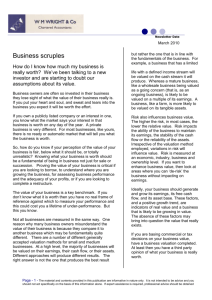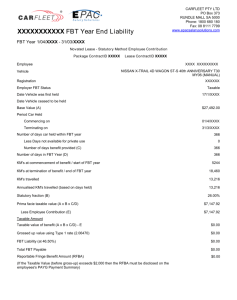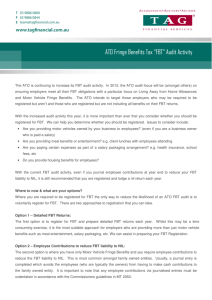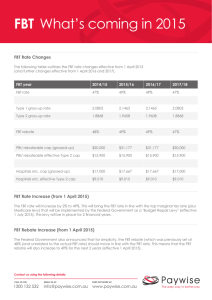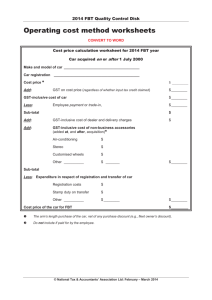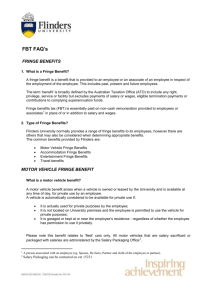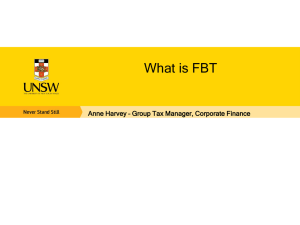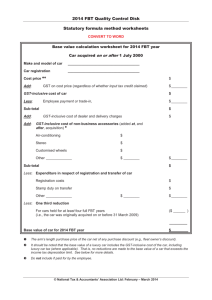Function Based Thinking (FBT) Presentation
advertisement
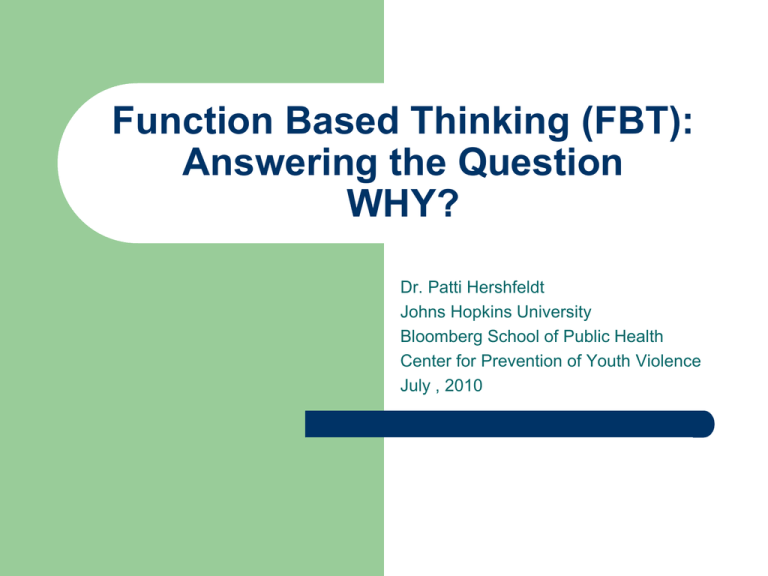
Function Based Thinking (FBT): Answering the Question WHY? Dr. Patti Hershfeldt Johns Hopkins University Bloomberg School of Public Health Center for Prevention of Youth Violence July , 2010 Introduction: Advance Organizer – Overview of PBIS Plus – The Goals The People Lessons Learned FBA/FBT Issues Overview of FBT Rationale 3 steps of FBT Case Study Strategies to Promote Use Overview PBIS Plus Catherine Bradshaw, PhD, Karen Pell, PhD, Richard Sechrest, PsyD, Patti Hershfeldt, EdD, Katrina Debnam, MPH, & Philip Leaf, PhD Johns Hopkins Center for the Prevention of Youth Violence Michael S. Rosenberg, PhD Johns Hopkins University School of Education Andrea Alexander, LCPC, & Milt McKenna, MBA Maryland State Department of Education Jerry Bloom, MEd, & Susan Barrett, MA Sheppard Pratt Health System Overview PBIS Plus Sample 31 elementary schools that have: – High fidelity PBIS – Interested in assistance supporting “yellow-zone” students County Schools in Maryland Design 3 year randomized controlled evaluation Random assignment to either “SWPBIS” or “Plus” condition Model Use of evidence-based interventions to support yellow-zone students Emphasizes function-based thinking and effective teaming Supports culturally appropriate interventions and supports PBISplus Liaison provides on-site technical assistance to facilitate the process Overview PBIS Plus Data Collected - Fall 2007: Staff Survey = 1,444 staff TOCA = 12,489 students Liaison Services Provided (Sept – May) 432 visits, for a total of 1,296 hours of on-site services to Plus schools Average of 3 hours per visit Average of 3.4 visits per month Most commonly provided support services were: Attending SST meetings Conducting classroom observations Consulting with teachers Conducting needs assessments One Lesson Learned: FBA/FBT Importance of FBAs – – – – Evidence-Based Practice Value to educational process Leads to validated Behavior Intervention Plans (BIPs) Leads to Important Changes in Student Behavior BUT….. One Lesson Learned: FBA/FBT FBAs Not Always Administered Why? Some reasons: – – – – – Limited Time Limited number of individuals trained to adequately perform functional analysis (Van Acker, Borenson, Gable, & Potterson, 2005) Associated with special education Limited technical assistance: FBAs Contextual mismatch One Lesson Learned: FBA/FBT The Challenge: How to Get the Benefits of FBA in the Current Context of Schools Testing of Function Based Thinking: A process designed to provide classroom teachers an enhanced and systematic method of dealing with behavioral issues (Not FBA) FBT: What is it? How Does it Differ From FBA? Ecological Considers context Simpler and user friendly Designed to support the needs of students w/less severe behaviors FBT: What is it? Ecological factors are ruled out – Double-Check (Hershfeldt, 2010) – Classroom management When Used? – – Conventional tactics have not been successful Likely candidates include our “Yellow Zone” students Differences between FBA and FBT Functional Behavioral Assessment (FBA) Function-Based Thinking (FBT) A process and a product Requires formal assessment and analysis informs the selection of effective function- of comprehensive data based supports Involves multiple team members Requires individual trained in behavior analysis or functional assessment A quick systematic way of thinking that A preliminary step, prior to an extensive FBA Only requires the teacher and an individual Typically a lengthy and intensive knowledgeable of behavior management to assessment and intervention process facilitate the learning process for teachers Not often used as a preventative measure, Draws from the research-based components but rather instituted when more of FBA problematic behaviors arise Designed to be used as an early intervention strategy with mild to moderate behavior problems Designed to be used prior to involving the student support team or outside supports 3 steps of FBT 1. Gathering information Emphasize data already collected by teachers 2. Development of a plan Ensuring interventions match function Matches teacher style and comfort level 3. Evaluation/monitoring of the plan Simple Gathering Information Antecedent, Behavior, Consequence data Data comes in many forms: – Student grades, homework and work completion, tardies, absences and even visits to the nurse or guidance office Let the data define the problem – How do we know it’s a problem? “Show me the data” Development of a Plan Its easy to become overwhelmed and rely on whatever intervention might have worked with a previous student Research suggests selecting an intervention that addresses the function of the behavior yields higher success in changing the targeted behavior (Scott et al., 2005) Development of a Plan Should take into consideration the function of the behavior – Answer the question WHY? Replace the targeted behavior Identify personnel that could help the student learn the new behavior – Be sure the personnel have the training to support the student Development of a Plan: Functions of Misbehaviors – the WHY? Avoidance – – – – – Unfamiliar w/the process or content Academic deficits Capacity (too much) Engagement (material isn’t engaging) Social skill deficit (doesn’t know how to interact w/ peers and adults) Access – Attention from peers, adults, to a favorite task Macintosh, et al. (2008) Development of a Plan: Functions of Misbehavior – the WHY? Avoidance – – To avoid a task To avoid a person/interaction (less common) What to do – – – Premack Build in breaks Permit escape for a specified time Development of a Plan: Functions of Misbehavior – the WHY? Access (Attention-Seeking) – Engages in behavior to satisfy (unconscious) need for attention Chronic blurting out, excessive helplessness, tattling, minor disruptions What to do: – – – Be careful about reinforcing the “problem behavior” Planned ignoring Provide attention and reinforce positive behavior Development of a Plan: Functions of Misbehavior – the WHY? Does the student have the skill? – Lacks ability or knowledge about how to behave What to do: – Explore psychological or constitutional factors – Have capacity for insight? If yes: Conduct lessons to develop skills and knowledge about appropriate behavior – Model, reinforce, and provide feedback If no: Make accommodations Development of a Plan: Functions of Misbehavior – the WHY? Is the student aware? – – Truly unaware that behavior is problematic Defensive, argumentative What to do: – – – Provide feedback Develop a signal to cue the student about the misbehavior Develop a self-monitoring and evaluation strategy Evaluate/monitor the plan Data collection should be on-going and simple (Jenson, Rhode, and Reavis (1995) in the Tough Kid Tool Box) Periodically compared with the baseline Reported to those involved – – including the student self-monitoring most effective See handout #1: The Three Steps of FBT See handout #2 The Case of the Disruptive Math Students Two students calling out frequently, disrupting the learning of others Step 1: Collect information – – – – When Where Who was involved ABC observations The Case of the Disruptive Math Students Step 2: Develop a plan – – Answer the question WHY? Teach and reinforce the replacement behavior: “ask for help” Step 3: Evaluate/monitor the plan Strategies to Implement FBT Teacher willing and able Training in FBT On-going coaching Evaluation (Fixsen, Naoom, Blasé, Friedman, & Wallace, 2005). Levels of FBT Student level – – Classroom level – Rule out ecological factors Empower the teacher to think functionally and plan accordingly Classroom Check Up (Reinke, Lewis-Palmer, & Merrill, 2008 ) School level – – Use of school-wide data Data based decision making Activity : Staff Response Form What did the student do ? (Be specific Measurable /observable What, when, who, ) How do I feel? What do I usually do? What do I say? What do I look like/sound like? Student shoved his I feel startled at book on the floor first and then I get in the direction of anxious his neighbors feet when I asked the class to begin working independently on their math assignments I usually send him to the office to conference w/the principal. I tell him, “Go straight there – do not pass go…” As a result, what does the student do? What is maintaining the behavior? Why is it happening? He spends the remainder of math class waiting for the principal to see him. AvT I believe he escaping to the office to avoid independent work in math. Adapted from Cooperative Discipline- Linda Albert- AA =Access adult attention; AP =Access peer attention; AC =access to choice; AI =Access to item; AvP = Avoid peer attention; AvA =Avoid adult attention; AvT = avoid task References Fixsen, D.L., Naoom, S.F., Blasé, K.A., Friedman, R.M. & Wallace, F., (2005). Implementation Research: A Synthesis of the Literature. Tampa, FL: University of South Florida, Louis de la Parte Florida Mental Health Institute, The National Implementation Research Network (FMHI Publication #231). Hershfeldt, P.A., Rosenberg, M.S. & Bradshaw, C.P. (2010) Function based thinking: A systematic way of thinking about function and its role in changing student behavior problems. Beyond Behavior 19(2). McIntosh, K., Horner, R. H., Chard, D. J., Dickey, C. R., & Braun, D. H. (2008). Reading and skills in function of problem behavior in typical school settings. Journal of Special Education, 42(3), 131-147. Reinke, W.M., Lewis-Palmer, T., & Merrell, K. (2008) The classroom check-up: A class wide teacher consultation model for increasing praise and decreasing disruptive behavior. School Psychology Review, 37(3). References Scott, T. M., McIntyre, J., Liaupsin, C., Nelson, C. M., Conroy, M., & Payne, L. (2005). An examination of the relation between functional behavior assessment and selected intervention strategies with schoolbased teams. Journal of Positive Behavior Interventions, 7, 205-215. Van Acker, R., Borenson, L., Gable, R.A., & Potterson, T. (2005) . Are we on the right course? Lessons learned about current FBA/BIP practices in schools. Journal of Behavior Education, 14(1).
